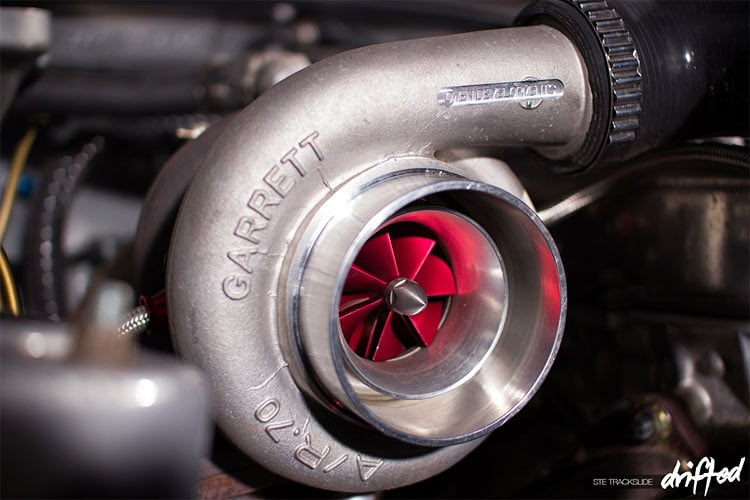9 Step SR20 Tuning Guide For Peak Performance
We show you exactly how to modify your SR20DET for enhanced power and reliability in our step-by-step SR20 tuning guide.

- Air Intake
- Mass Air Flow Sensor
- Intercooler
- Fuel Injectors
- Fuel Pump
- Exhaust System
- Turbocharger
- Boost Controller
- ECU & Tuning
In a hurry? Watch our SR20DET tuning guide summary
Introduction to SR20DET tuning
Welcome to our SR20 tuning guide, this guide contains nine tuning tips that when implemented correctly should have your SR20DET running at peak performance.
WARNING: Before we dive into this tuning guide you need to consider that running your SR20DET at higher than factory power levels will put additional strain on all parts of the drivetrain. Depending on how far you push your engine you may need to upgrade to a stronger clutch and quite possibly a stronger gearbox.
The Silvia S15 six speed manual transmission is rumoured to hold up to around 350ps but pushing higher figures than that is not advised. As an alternative the Nissan 350z gearbox is a good candidate for a swap being robustly engineered and also a six speed.
You will also need to look into cooling, an upgraded radiator and higher pressure radiator cap will help to keep engine temperatures down. Although it looks ugly and takes up space in the ‘bay, within the SR20DET community it is widely recommended to retain the standard viscous fan and fan cowling.
Please also bear in mind that I am an enthusiast, not a professional. I am giving this advice in good faith, if you have any doubts what so ever please contact your local trusted tuner or garage and discuss your plans with them.
Now on with the tuning tips!

About the SR20DET
This Japanese built turbo charged four cylinder engine has powered over two decades of reliable drift cars. It is relatively cheap to purchase, reliable up to circa 400ps on stock internals and it is extremely tuneable.
What is the history of this engine? What versions of the SR20 exist? What cars did they come in?
The first SR20DET that rolled out of the Nissan Motor Company’s factory in 1989 could be found transversely mounted in the Nissan Bluebird 2000SSS.
A couple of years later in 1991 Nissan decided to redesign the mounting of the engine and flipped it longitudinally for it’s upcoming rear wheel drive coupé platforms. The first car to use this new configuration was the Nissan 180sx (S13).
All through the nineties Nissan tweaked their four cylinder SR20, along the way releasing a naturally aspirated SR20DE that found it’s way into most of the rare Nissan Silvia convertible range.
In the mid-nineties the Nissan Silvia / 200sx (S14) received the new “bentcam” SR20DET, this offered Variable Valve and Timing, bigger injectors and a larger T28 turbo charger.
The final incarnation of the SR20DET was built for the Nissan Silvia Spec R (S15). This version featured all of the improvements Nissan had engineered over the past nine years and in addition squeezed out an extra 50ps.
SR20DET engine specifications
Here are the specifications from the final ‘bentcam’ SR20DET that was housed in the S15:
- Manufacturer: Nissan
- Version: Nissan Silvia Spec R S15 (1999-2002)
- Displacement: 1998cc (rounded to 2.0 liters)
- Configuration: DOHC (Dual Over Head Cams), 16 Valves, Chain driven cam sprockets
- Power: 250ps @ 6,400 rpm
- Torque: 220 lb ft
- Turbo: T-28 Ball Bearing T2 Flange
- Stock boost: 7 psi
- Cars that housed the SR20DET: Nissan Bluebird, Nissan Pulsar, Nissan Sunny, Nissan 180sx, Nissan Silvia, Nissan Avenir, Nissan Liberty, Nissan R’nessa, Nissan 200sx
You can read more SR20 specs right here.
Now we have discussed the history of the SR20 and the cars that it came in let’s dive into the tuning.
Tuning philosophy
Basic engine tuning philosophy is pretty simple; Think of the engine as a giant air pump. Air comes in through the air intake, it is compressed on it’s journey by the turbocharger, it combusts in the engine and the waste is shot out of the exhaust.
Our approach to obtaining more power is to increase the amount of air coming into the engine, increase the air density by upgrading the turbocharger and to decrease the air flow restrictions of the exhaust system to allow waste to get out as quickly as possible.
These nine tuning tips aim to achieve this without needing to open the engine itself, while also keeping your SR20 running safely. In the tuning community you would refer to this approach as “bolt-ons” because you are not opening the engine.

Tuning tip #1: Upgrade Your Air Intake
The first SR20det tuning tip is to upgrade the engine’s air intake. Factory air intake systems are designed with dual purpose; to filter dirty air and to restrict intake noise.
An aftermarket performance air intake system is going to be focused purely on getting as much clean air into the engine as possible at the sacrifice of increased levels of intake noise. There are many aftermarket air intake systems available for the SR20DET and many of those have lofty power claims.
I would take those claims with a pinch of salt.
The MKIV Supra forum published an interesting article testing four different premium air intake kits on the same 2JZGTE, although it is not an SR20DET and the figures won’t exactly add up you get a good feel for which filters perform the best.
If it was my money I would pick the APEXi Power Intake.
I have used this air intake on my own cars in the past and I have always been happy with it. Unlike the foam filters this is also washable.

Tuning tip #2: Upgrade Your Mass Air Flow Sensor
As the name suggests the Mass Air Flow Sensor is a simple device that measures the volume of air coming into the air intake, this information is relayed to the car’s ECU so that the correct air / fuel mixture is set.
The original SR20DET was built to produce 200bhp at the flywheel, the engine used a Mass Air Flow Sensor with generous headroom all the way up to 300ps however to go over this we are going to need to look at the SR20det’s older brother for parts..
A Nissan 300zx Z32 model Mass Air Flow Sensor should be perfect to support our targeted power level and a brand new ISR Performance Z32 MAF can be found here.
Recently, tuners are steering away from the outdated Z32 MAF in favor of the modern-day equivalent found in the R35 GTR.
Although this may sound like overkill for SR20DET’s, it’s very similar to the outdated 20-year-old Z32 AFM, with a touch of updated technology.
With improved precision, the R35 GTR mass air flow meter allows for a far stable tune, eliminating the “MAF stalling” issues that many experienced with the Z32.
If you’re planning on going down the MAF route, we highly recommend opting for the R35 option over the Z32.
Another option is to ditch the Mass Air Flow Sensor entirely and go with a MAP sensor setup, this will do away with the ugly looking MAFS but I don’t really see the need unless you are going for seriously high power figures.

Tuning tip #3: Install A Front Mount Intercooler (FMIC)
The third SR20DET tuning tip I have for you is to ditch the stock (wing mounted) intercooler and replace it with a large front mounted intercooler.
An intercooler is designed cool the air charge – the cooler the air charge, the denser the air, the denser the air the more efficient the combustion cycle. By replacing the standard intercooler with a larger unit and placing that behind the front bumper (rather than in the wing like in most s-chassis) means more airflow to the intercooler and that means better cooling.
Which unit you choose depends on your budget but in my own 180sx SR20DET build I used a huge front mounted intercooler (S14, S15) – (S13). There are also plenty of cheaper alternatives on the market.

Tuning tip #4: Upgrade Your Fuel Injectors
The fourth tip to building your SR20DET into a true bad ass is to replace your standard fuel injectors with larger ones. Each different generation SR20DET’s came with different sized fuel injectors but if you want to turn up the wick on the power then you will want to increase the displacement of your fuel injectors.
Standard fuel injectors will work fine with the turbo boost setting at a stock or at slightly increased level however to really hike up your engine power you are definitely going to need to increase the size.
A set of four 550cc fuel injectors should do the trick. You can go even bigger in size for safety and future power headroom and just instruct your tuner to turn down the fuel duty cycle for now.
The FiveO 550cc fuel injector set should do the job. I haven’t personally used FiveO before but they seem to get good reviews.

Tuning tip #5: Upgrade Your Fuel Pump
Your car’s standard fuel pump has been around for at least 14 years (in the case of a late model Silvia S15) so it is probably due a replacement anyway, an engine leaning out from fuel starvation is going to go bang pretty quickly and we don’t want that.
When aiming for over 300ps you will definitely want to upgrade the standard fuel pump to a larger, higher capacity unit.
A pump that is flowing more fuel is going to provide a lovely, high pressure fuel stream to feed your larger fuel injectors. These two supporting modifications are going to allow you to safely increase the turbo boost pressure.
A good aftermarket fuel pump is a Walbro High Pressure 255 ltr/hr in tank fuel pump.

Tuning tip #6: Upgrade Your Exhaust System
Like the factory air intake your standard exhaust system is designed as a compromise between providing performance and keeping down the sound level.
An aftermarket performance exhaust system will offer increased pipework size and crucially less bends and obstructions to ensure that the exiting engine waste can leave the exhaust as quickly as possible.
As for which system to get you have a huge selection of exhaust systems on the market to choose from. For my choice at a reasonable price level I would pick the APEXi N1, this system has been around for a long time and is a proven performer for a reasonable price.
Our sister site the 180sx Club has written a detailed exhaust guide listing many of the currently available exhaust systems for the Nissan S13, S14 and S15. The guide also includes pictures and videos of each exhaust system so you can get a real feel for the exact look and sound that you want.
We highly recommend upgrading the SR20DET’s restrictive manifold (header) alongside an aftermarket exhaust to maximize the airflow.
While the Tomei Expreme Manifold is a popular choice for those looking for a simple setup, there are plenty of other alternatives.
Those looking for a cheaper option will want to check out the ISR Performance V2 Tubular Exhaust Manifold.
ISR Performance also offers premium RamHorn Top Mount, and Tubular Bottom Mount manifold alternatives if your plans are a bit different.

Tuning tip #7: Upgrade Your Turbocharger
The turbo charger one of the most complex and the most expensive upgrades on our SR20DET tuning list. There are so many options, trim levels and intake sizes, exhaust sizes etc I cannot confidently cover them all.
So instead let’s try to keep it as simple as possible; if our goal is to increase the engine output to 350ps – 400ps at the flywheel I would stick with a T2 flange. This means that we can reuse the standard (cast iron) exhaust manifold and fittings and just swap out the turbo charger unit itself.
To produce higher power outputs without an excessive amount of turbo-lag I would suggest a Garrett GT2871R turbo charger.
Garrett are one of the most well respected turbo manufacturers and the GT2871R is an ideal pairing with a properly supported SR20DET. This turbo is both oil and water cooled and has a great reputation.
Alternatively, if you’re after a newer update to the ever-popular GT2871R, then Garrett’s latest offering, the G25-550 turbo, is seen by many as the ultimate choice.
If you’re unsure which is best for you, check out this video from Adam LZ, where he fits the G25-550 turbo to his SR-powered S13 before heading to the dyno:
Garrett parts are readily available if you ever need to service the unit.
If you’re looking for a complete turbo kit for the SR20DET, we highly recommend checking out these offerings from ISR Performance.
ISR Performance Garrett GT2871R Turbo Kit Package
- Garrett GT2871R-RS turbo
- ISR Performance Bottom Mount Turbo Manifold
- ISR Performance Turbo Lines for S13 or S14
- Clocking adapter and Wastegate Rod Extension (S13 Only)
- GT fitting and drain kit (S13 Only)
- Oil Restrictor for Garrett Ball Bearing Turbos (S13 and S14)
- ISR SR20DET 7 Layer Exhaust Manifold Gasket
- ISR 4 Bolt Turbine Inlet Gasket
ISR Performance RS3871 Turbo Upgrade Package
- ISR Performance RS3871 Turbo drive (rated to ~380hp)
- ISR Performance V2 Bottom Mount Turbo Manifold
- ISR Performance Turbine O2 Housing
- ISR Performance Turbo lines
- ISR Performance Intake Kit
- All gaskets, couplers, clamps, and hardware (Does not include new exhaust manifold studs to the head)
If you would like to take a deep dive into which is the perfect turbo for your SR20 then check out our complete SR20DET Turbo guide.

Tuning tip #8: Install A Boost Controller
Now that all the supporting modifications in place on the intake side, the fueling side, the turbo charger and the exhaust side we can look at increasing the boost level.
In order to do this an electronic boost controller is the next item on our shopping list. By replacing the standard restrictive boost controller with an aftermarket item we can control the turbo charger boost pressure level from inside the cabin.
An attractive control unit will be fitted inside the cabin, normally around the dashboard area and this can be used to set the boost level.
Alongside setting the boost pressure level most modern boost controllers feature a ‘Scramble boost‘ setting, this setting is designed to spike the boost for a short amount of time, useful for performing an overtake.
GReddy is a highly regarded Japanese tuning brand and their Profec OLED boost controller is a lovely little toy. It is a modern, sophisticated and compact machine that is packed with features. This will make a great addition to any dashboard.
Cheaper boost controller alternatives are available, a simple manual boost controller will get the job done.

Tuning tip #9: Upgrade Your Engine management & Tuning
Everything is now in place to seriously hike up your SR20DET’s power output, all that is left is upgrading your car’s ECU and getting it professionally tuned. Standard ECU’s are tough to work with and most older cars require soldering on a chip that contains the custom tuning ‘maps’ which are needed to run your new performance components at their optimum level.
A standalone replacement Engine Management System such as an APEXi Power FC is a plug and play unit that neatly swaps with the standard ECU.
This ECU can also use a ‘Commander’ which is a cool little gizmo that you can mount on your dashboard to monitor vital engine statistics, temps, revs etc and also if needed you can create tunes on the fly.
Although the APEXi Power FC has continued to be a popular choice over the years, many see it as outdated technology compared to some of the other options on the market today.
One of the most impressive choices for SR20DET ECU’s in the present day comes from Link Engine Management.
Link makes off-the-shelf ECU’s for S13/S14 and S15 Silvia’s.
Now that the ECU is in place it is time to find a local tuner. Tuners can be hit and miss so it is really worth doing your research and asking around your local tuning community or owners clubs to find people willing to recommend a tuner. You will also want to make sure that your tuner is familiar with the SR20DET.
All of these fantastic aftermarkets parts will come to nothing if the tuner you select does not know how to safely tune a car. I am based in the United Kingdom and I have always used the London firm FC Tuning for all of my ECU tunes.
Drifted is not sponsored by FC Tuning, they are simply my personal preference. Steve has tuned my 180sx and JZX90 in the past so I trust him with my engines.

Conclusion
With all nine steps of our SR20 tuning guide followed and a healthy base engine you should be looking at the thick end of 300ps at the flywheel. Furthermore your engine should also be putting out some ferocious torque and you will really feel that.
Professional race shops and tuners have built SR20DET engines to hit far bigger numbers than these but to do that safely you will need to start upgrading your internal engine components such as pistons, rings, con-rods etc.
If you want to change the driving characteristics you can also look at stroker kits to increase your engine displacement. There are plenty of stroker kits on the market, the TOMEI 2.2 kit gets a good reputation and is often used on JDM tuner builds. TODA produce very popular 2.2 liter stroker kits.
Crate SR20DET engines
If you want to extract some next level power and reliability (and if you have deep pockets) a crate engine from TOMEI might be a good choice. The TOMEI GENESIS has a mouth watering specification and a great reputation, but TOMEI has unfortunately discontinued production.
There are many other tuning parts which can help you get to the 400ps figure that I haven’t mentioned including aftermarket camshafts, intake and exhaust manifold upgrades, cylinder head work but for this tuning guide I am keeping it as simple as possible.
You could also go down the route of Nitrous Oxide..
Wondering what a tuned SR20DET is capable of? Check out this 1971 Datsun Ute with a 1000 horsepower SR20 stuck under the hood.
Or what about this equally impressive SR20DET powered “Cage-Car”
For more tuning guides just like this for other popular drift cars, check out our tuning guides section.
Now that you are an SR20DET tuning genius why not check out how this engine fared against the mighty RB20DET? Maybe Nissan engines aren’t for you? Why not check out Mitsubishi’s 4G63T? Some say it’s the best 4-cylinder ever!
If you are passionate about SR20’s then take a look at Speedhunter’s SR20 archives to discover more great content.
Want an instant hit of drifting action? Try our free to play drifting games.























